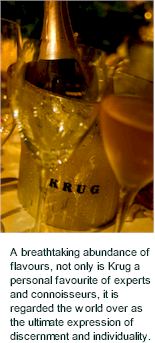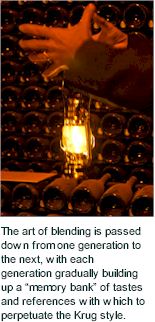


Krug’s founder, Johann-Joseph Krug, was a maverick who turned his back on a comfortable position in an established champagne house to strike out on his own. He had not only the vision, but also the talent, to achieve his ambition of creating a champagne with a taste quite unlike any other. Theirs is a living legend, a certain idea of excellence that has been quietly redefined through six generations without a break. Subsequent generations of the Krug family not merely honoured his achievement, but amplified it, bringing genuine pride and passion to their craft.

Krug today is the result of a continuity – of vision, of spirit, of passion – that is an absolute rarity in any time or place. To discover Krug is to share in that spirit, to sense that passion, to experience something truly exceptional. Intense, inspiring, individual, Krug is a revelation every time. From meticulous grape selection, through the birth of the wine in small oak casks, to the intricate process of “assemblage”, followed by long years of aging in the cellars, Krug champagne is the culmination of painstaking care and unrivalled craftsmanship.
From the grape to the glass, Krug champagne is nurtured with painstaking care and attention to detail. The Krug philosophy is, first and foremost, about a passionate commitment to craftsmanship, defined by a series of uncompromising choices which, taken together, create a taste, a style, that is as legendary as it is unique.
Of fundamental importance to the Krug style is its approach to grape selection. Krug sources its grapes, not from a few large vineyards, but from an intricate mosaic of fine-quality plots, some of which are not much bigger than gardens. This choice is based on Krug’s knowledge of the terroir of Champagne, and the fact that the same grape variety cultivated in different vineyards develops subtle nuances of flavour. As a result, the wine is more exciting – the more you drink, the more you discover. Krug knows which areas best suit its style, and endeavours to secure the best-quality supplies from those areas – indeed, some farmers have been supplying the Krug family with grapes for generations.

The grapes, selected by hand, are pressed to obtain the “must ”, which is transferred to 205-litre oak casks, individually labelled by area and vineyard. It is in these small oak casks that the wines are born. Alone among the great champagne houses, Krug still ferments all its wines in oak – not out of some slavish devotion to tradition, but because only this method can bring each and every wine so vibrantly to life. Another advantage of the first fermentation in oak is that the exchanges which take place between the wine, the wood of the casks, and the oxygen in the atmosphere naturally favour a slow, long evolution of the wine, resulting in the exceptional longevity of all Krug champagnes.
Time is the greatest luxury of all, and Krug, which has spared no effort in the making of its champagnes, now allows them all the time they need to reach maturity. For this reason, every Krug champagne is aged for upwards of six years, and in some cases much longer. Not until each has attained its perfect balance of freshness and fullness will it be released from the cellars in Reims. At Krug, a passion for the craft is also a matter of patience.
To guarantee the consistent excellence of the Krug style, despite the vagaries of climate and harvest, Krug can draw on a resource unrivalled in Champagne – its stocks of reserve wines. These are a selection of the best still wines from previous harvests, carefully stored in the Krug cellars. Like a perfumer’s library of fragrance essences, reserve wines are among Krug’s most precious raw materials, for it is the only champagne house to use them as a significant part of the structure of the blend. Above and beyond consistency, reserve wines create both harmony and complexity – indeed, for Krug, they represent the very essence of “assemblage”.
“Assemblage”, or blending, is one of the miracles of champagne, and the culmination of Krug’s craftsmanship. Different grapes from different vineyards and different years are blended together to create a whole that spectacularly surpasses the sum of its individual parts. The process of “assemblage” culminates over one week in February. It is the most crucial week of the year at Krug, on which the work of all the others depends. There can be no formula, no recipe, given that no two harvests are ever quite the same.
